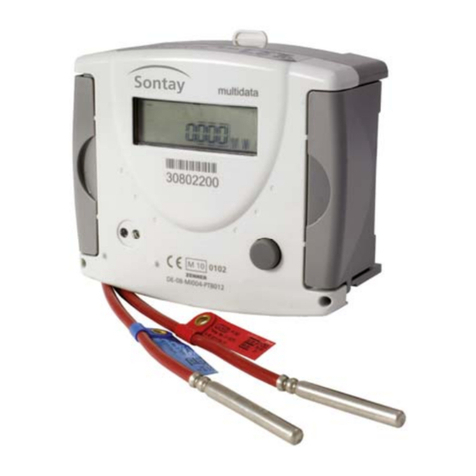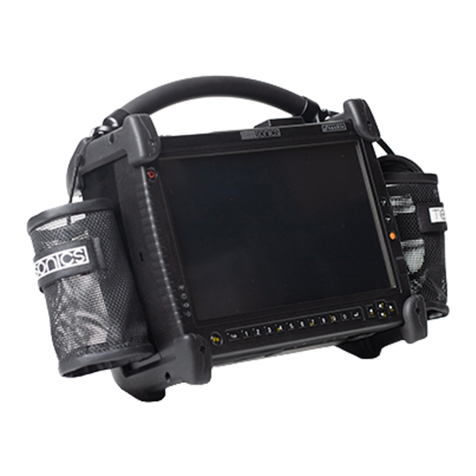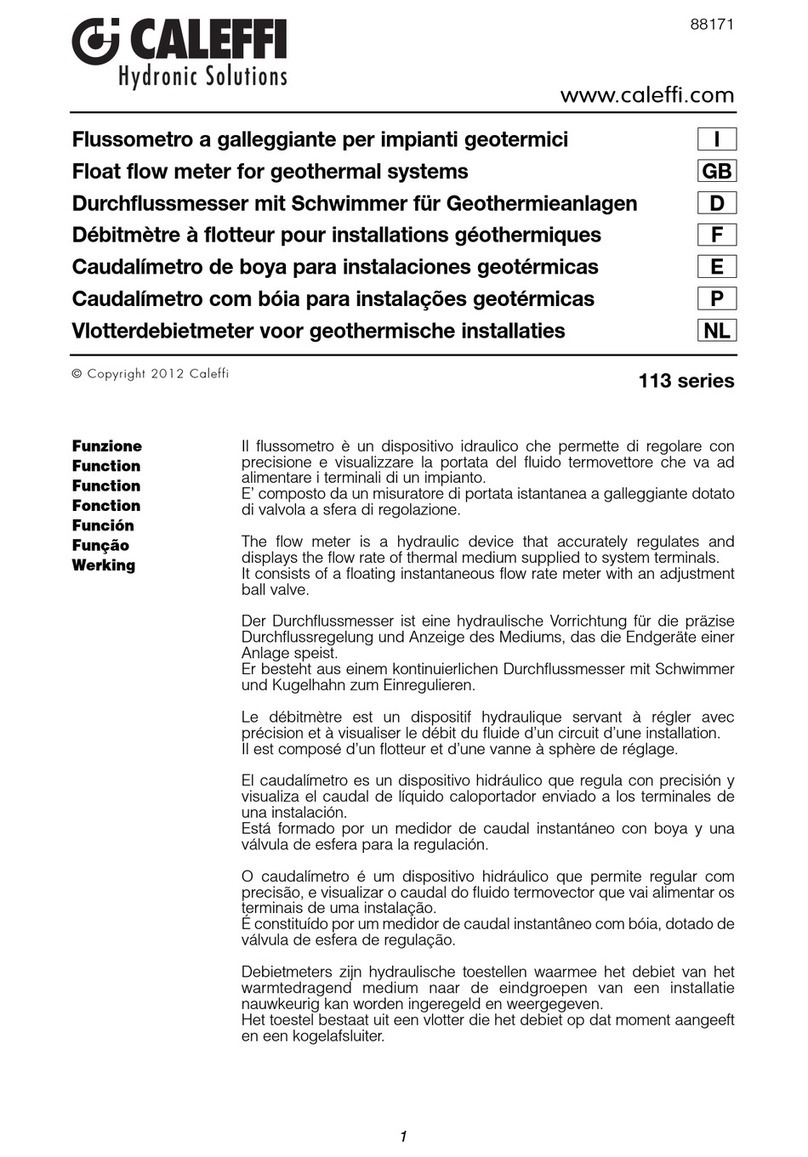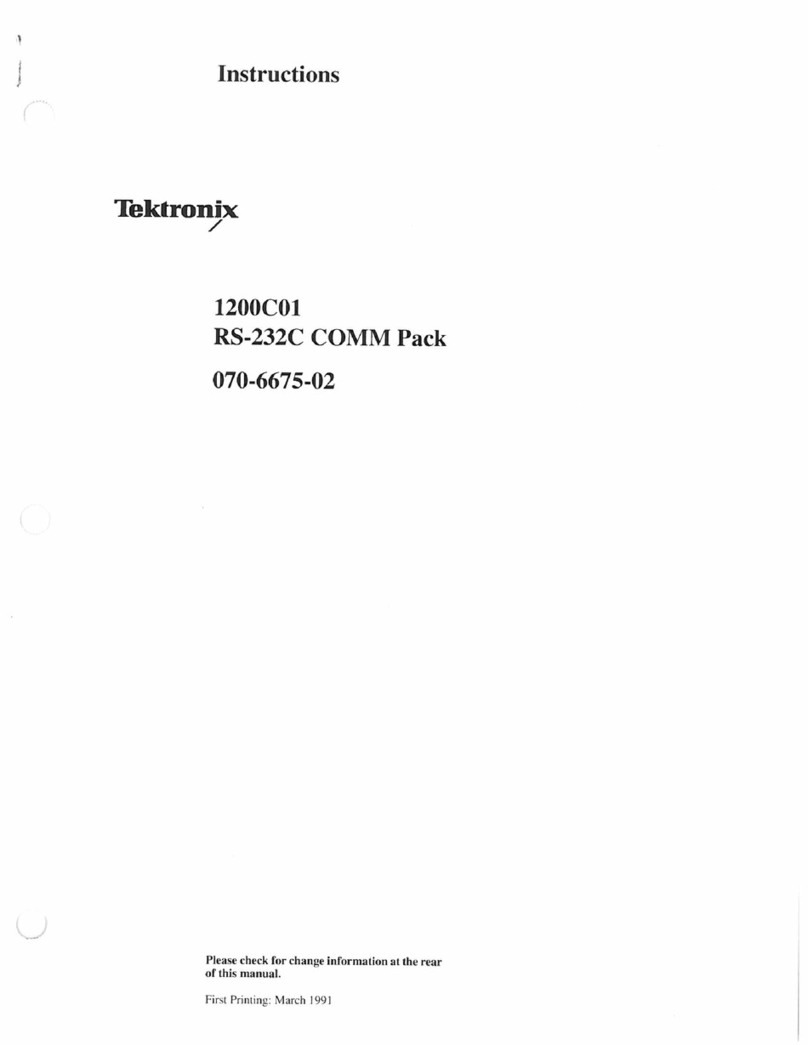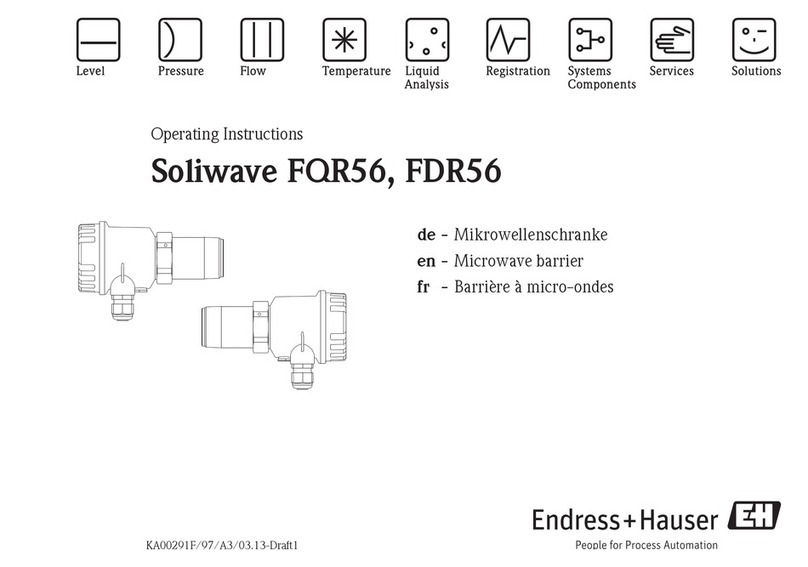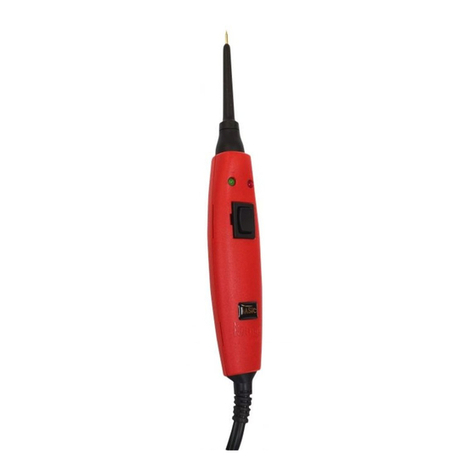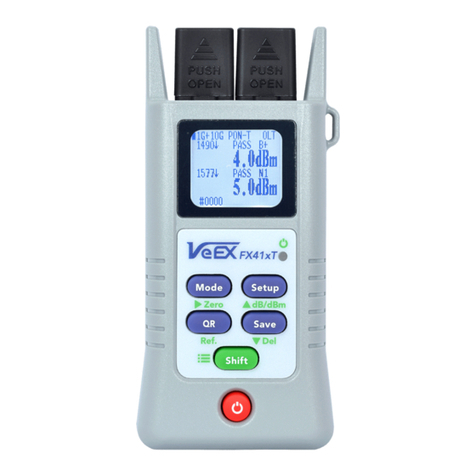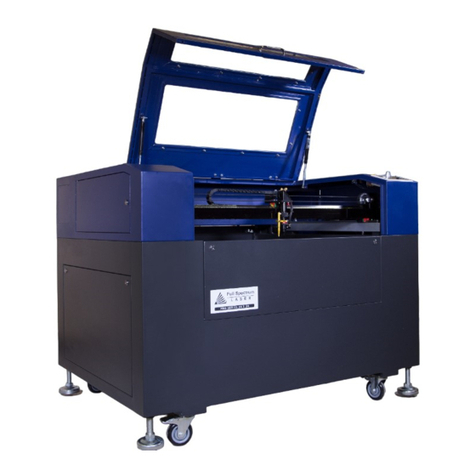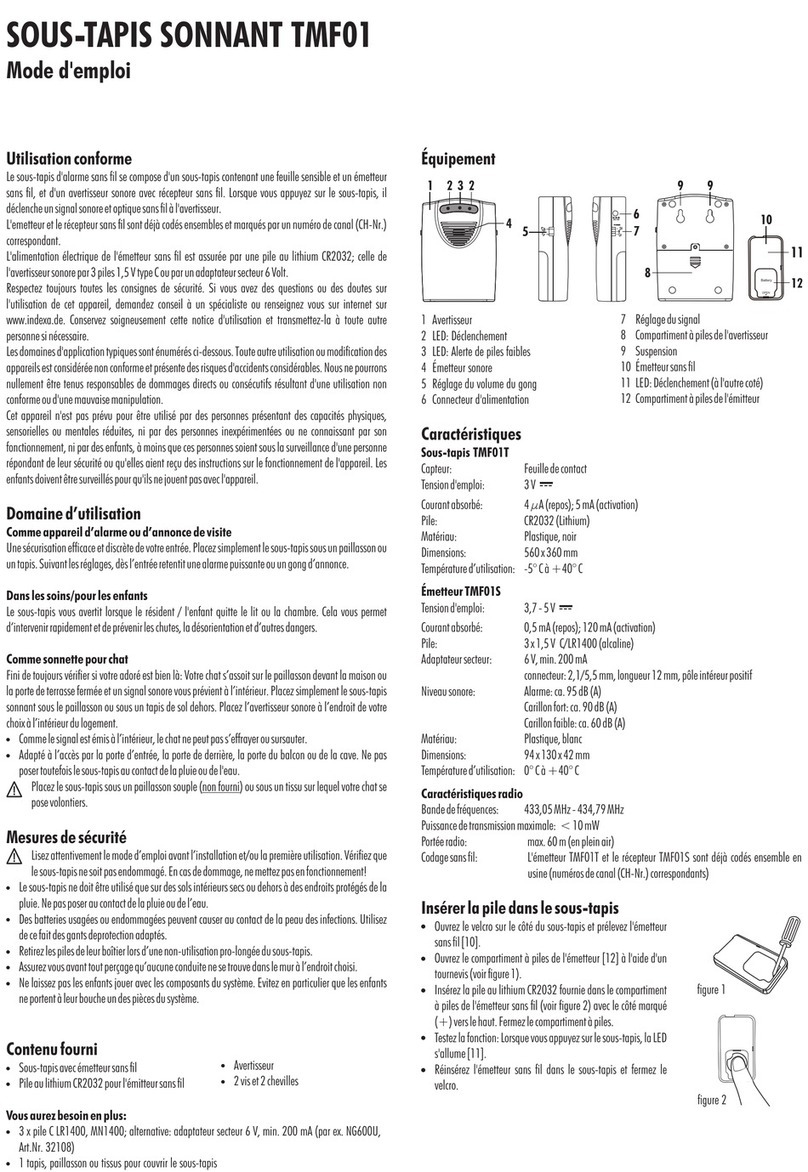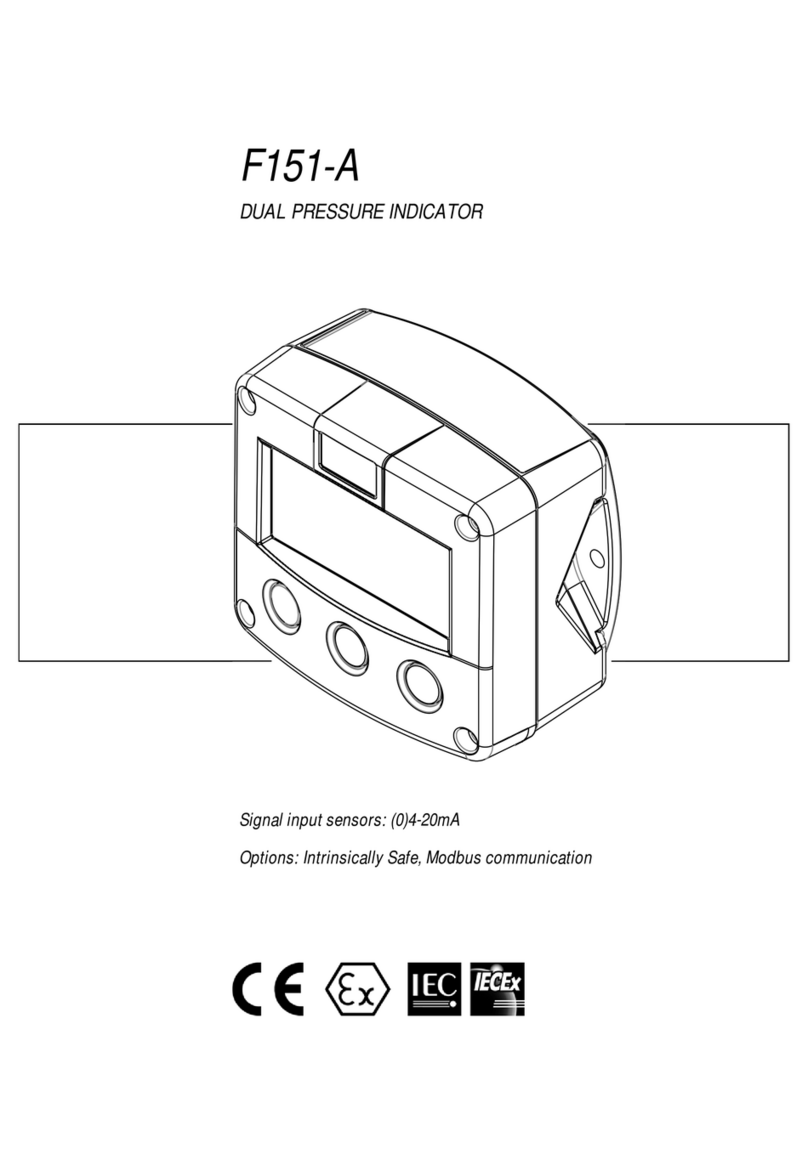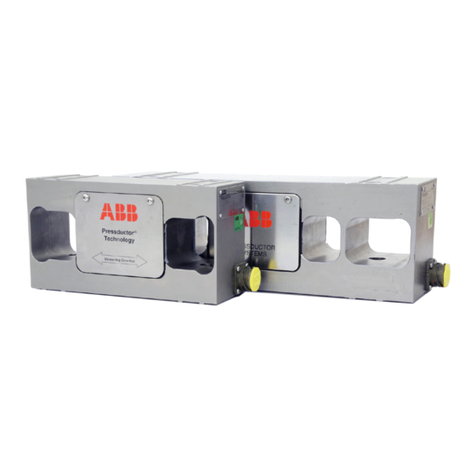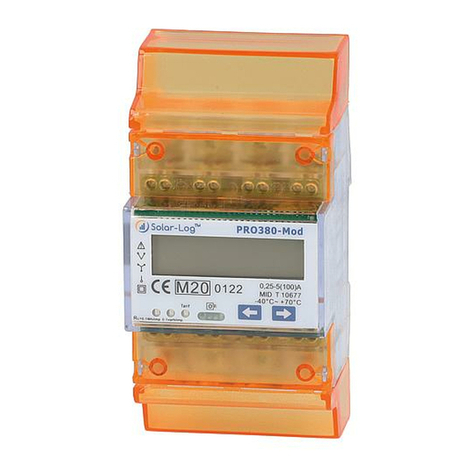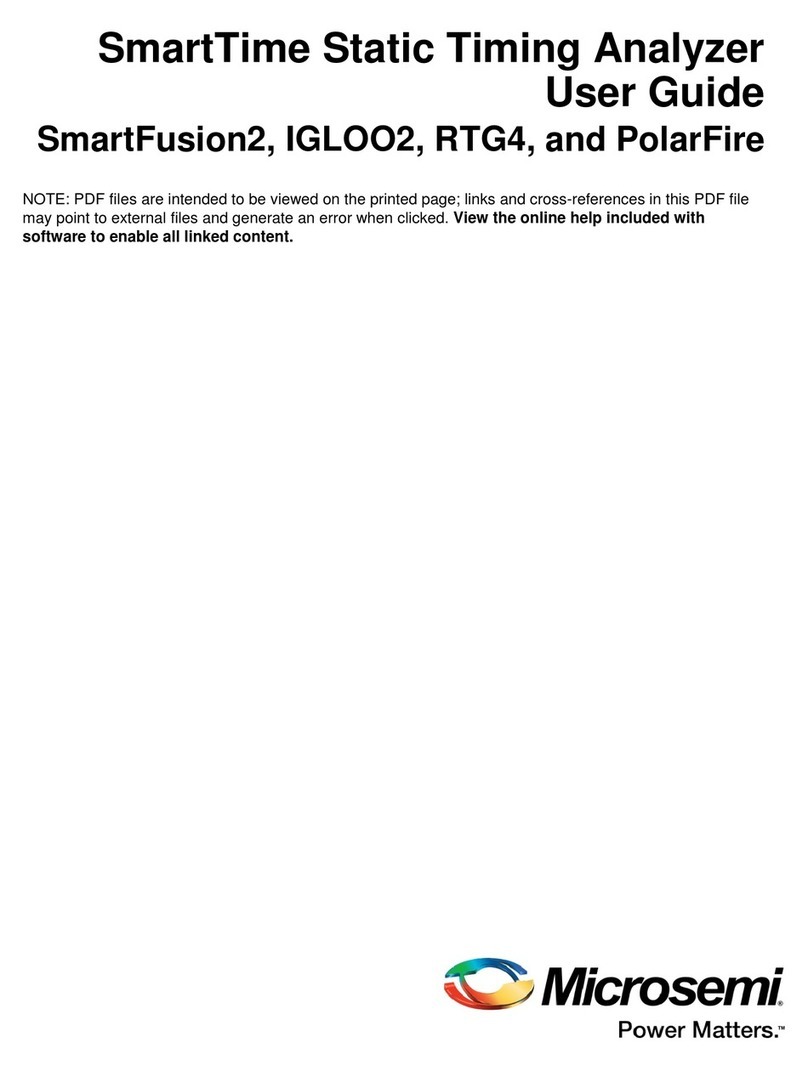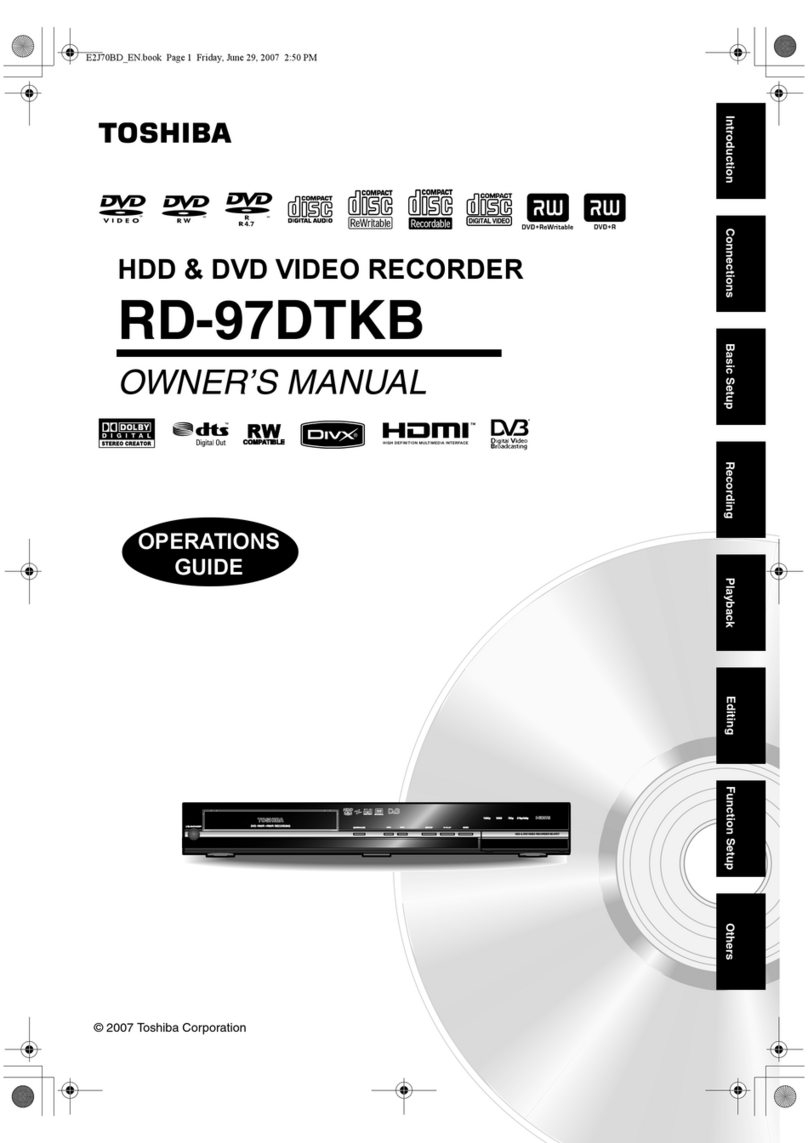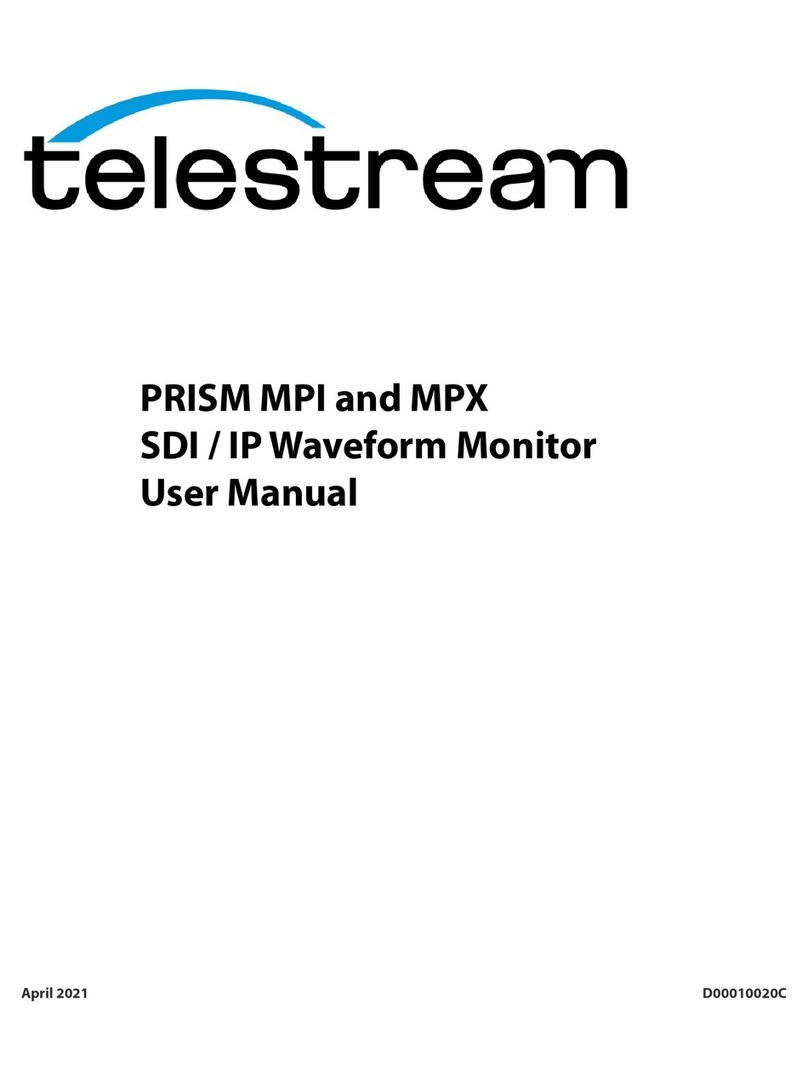Sontay LS-MC User manual

UK Sales Tel: 0845 345 7253 International Tel: +44 1732 861225
Ultrasonic Level Transmitter
Page 1 of 8
LS-MC
Issue: 5.0
Date Of Issue: 10/06/2009
© 2009 Sontay Limited. All rights reserved.
Features
Specification Product Codes
• 2-Wire loop powered
• IP67 Housing
• 12 to 30Vdc power supply
• Fast speed of response, as much as 10m per minute
• Locking nut supplied
Measurement range 0.3m to 8m
Output 4-20mA
Supply 12 to 30Vdc loop powered
Load impedance 750Ωmax.
Cable entry 2 x M20 x 1.5mm
Max. cable run 3000m (1.86 miles)
Display Integral 4-digit LCD
Beam angle ±6° (3db)
Resolution Better than 1mm
Accuracy (measured range)
<1.0mm ±5mm
>1.0mm ±0.5% of measured distance
Damping 1 to 99 seconds (adjustable)
Process connection 2” BSPT
Temperature range -20 to +70°C
Operating pressure -0.25 to 3bar max. (20°C)
Material:
Transducer PVDF
Housing Glass filled nylon
Dimensions 205.5 x 141mm overall
Protection IP67
Conformity EN50081-1 & EN50082-2
Country of origin UK
LS-MC
Ultrasonic 4-20mA level transmitter, c/w locking nut
Accessorys
LS-NUT
Additional fixing nut
LS-FK
Adaptor flange for LS-UL3 fixings

Page 2 of 8
UK Sales Tel: 0845 345 7253 International Tel: +44 1732 861225
LS-MC
Issue: 5.0
Date Of Issue: 10/06/2009
© 2009 Sontay Limited. All rights reserved.
Technical Overview Installation (continued)
The LS-MC is a ultrasonic level transmitter for measurement
of liquids in tanks or sumps. The 4-20mA output represents
the distance between the surface of the liquid being de-
tected and the sensor.
The LS-MC has a integral LCD display, 3 push buttons under
the lid for security, and just 8 parameters to set making it
one of the simplest ultrasonic level transmitters to calibrate
and use.
Installation
1. Ensure the LS-MC has a clear uninterrupted path
between the transducer face and lowest fluid level.
2. Mount the LS-MC away from filling points, walls and
ladders with it's face horizontal.
3. Mount the LS-MC at least 0.3 metres above the highest
liquid level and 0.88 metres away from walls.
4. Do not over tighten the fixing nut, only tighten by hand.
Use the hexagon nut, not the housing.
5. Keep the LS-MC away from high voltage/current devices
and variable speed drives.
6. Shield the LS-MC from direct sunlight.
7. If used with a liquid where foaming could occur, locate
the LS-MC over an area of clear liquid. Failure to comply
will result in a reduced size of the return echo, thus an
incorrect reading.
8. Applications where heavy condensation is likely on the
instrument face should be avoided.
9. The LS-MC is not suitable for use in a hazardous area.
10. The electrical connections are Red = 24-36Vdc supply,
and Blue 4-20mA output.
C Min. 0.88m
D Min. 0.3m
D Max. 8m
3° max.
C
D
Min. R3.0mm
Max.
0.35m
Min. 0.15m

Page 3 of 8
UK Sales Tel: 0845 345 7253 International Tel: +44 1732 861225
LS-MC
Issue: 5.0
Date Of Issue: 10/06/2009
© 2009 Sontay Limited. All rights reserved.
Connections Display Units
Cable type:
Min. 0.22mm² (24 SWG / 23 SWG)
Max. 1.5mm² (16 SWG / 18 SWG)
Operation
A programming card is supplied inside the LS-MC, a copy is
on page 8.
The programming card shows the pre-programmed parame-
ters that are held in the memory.
Power Up
On power up, the LS-MC will take a few seconds to initialise,
then the display will run through a set-up routine, showing a
full set of figure eight’s, then the software revision and
finally a full set of zeros whilst the microprocessor identifies
the correct return echo and confirms this repeats enough to
be acceptable.
The instrument is now ready for use, and is set-up using the
3 coloured push buttons.
Refer to the programme menu which is on page 8, and also
in the instrument itself on a card tucked between the elec-
tronics housing and the body.
The LS-MC default value is meters.
The display units can be changed using the blue button .
Simply hold the blue button down for 10 seconds and the
units will change to the next option in the following
sequence :
Metres to Feet to Inches and back to Metres again.
This is indicated by the position of the decimal point in the
displayed value :
Once the units have changed from default to the next
option, the blue button can be released, in which case the
new units selected are confirmed, or the blue button can
continue to be held down, in which case the next units
option is given after a further three seconds.
When the display units have been programmed, please note
that you must use the same units when programming in the
bottom reference, 4 and 20mA points.
The 4-20mA output may be set to operate over all or just a
part of the total measuring range. There is no theoretical
limit on the minimum span of the current output, although
in practice a span below 100mm is not recommended. With
small spans, be aware that a high value of damping will
greatly affect the performance of LS-MC.
The 4mA level may be set above or below the 20mA level to
suit the monitoring or control equipment.
Note: The LS-MC measures and calculates at all times in
metres. The units of display are derived as a last operation
using a pre-programmed conversion factor.
First Measurements
With the LS-MC installed and display units selected, the
display will now be showing what the instrument thinks is
the liquid level. This is a value calculated by the microproc-
essor, being the difference between the distance to target
being measured and the default value for the datum or
bottom reference (b.rEF).
+
-
24Vdc Supply 4-20mA Output
Units Display
M8
ft. 26.24
in. 314.9

Page 4 of 8
UK Sales Tel: 0845 345 7253 International Tel: +44 1732 861225
LS-MC
Issue: 5.0
Date Of Issue: 10/06/2009
© 2009 Sontay Limited. All rights reserved.
First Measurements (continued) Setting The Correct Bottom Ref. (b.rEF)
Before changing any of the default values, use blue button
to scroll along to the next piece of information, which is
the distance to target as measured by the LS-MC from the
front (transmit) face. This value is shown alternately with
the text “diSt” to remind the user the LS-MC display is in
distance mode. You can now quickly check correct operation
against a manual measurement if required.
Tip: A feature of the LS-MC useful at this stage is that it can
be used as an electronic tape measure. With an empty tank
or vessel, the LS-MC will read the distance to the bottom of
the tank. This can be noted and used when setting b.rEF
later.
Press blue button again to scroll the display to show the
echo size on a scale of 0-100. (It is possible to record a
value greater than 100, but do not worry about this!). With
the display in this mode, the central “:” cursor will flash once
for every echo received, which under normal circumstances
will be approximately once per second.
Tip: It is useful at this point to check that the maximum
echo size available is being received. Adjust the position of
the instrument until the highest echo size is shown
continually. In most applications, the signal strength will
vary over a wide range : 20 – 80.
Press blue button now to return to the original level read-
ing and to start the calibration routine.
Note that the output of the LS-MC will vary during program-
ming as the various default values are changed. The display
will automatically revert to the level or distance reading from
any other display after a period of 4 minutes.
1. Press green button and the display will scroll from the
level reading to “b.rEF”.
2. Press blue button . to enter the editing menu for b.
The display will show the present value of the b.rEF
parameter.
3. If this value is correct, press red button , then green
button to scroll on to the next menu option.
Or
To change the value, press blue button to edit :-
The first digit of the display will flash and may be changed
using green button . Once correct, press blue button to
select the next digit and then green button to edit, or the
blue button again to move to the next digit. Continue
this sequence until all 4 digits are correct, then press the
blue button a final time to confirm the new b.rEF value
(none of the digits should now be flashing).
If the new value is incorrect, the edit sequence for b.rEF can
be started again by pressing the blue button . If the new
value is correct, press the red button to save the b.rEF
programmed in and the display will automatically scroll on to
the 4mA (4) setting menu.
Setting The 4 and 20mA Levels ( 4 & 20)
The 4mA level may be set above or below the 20mA level to
suit the monitoring or control equipment.
If you wish to set the 4 and 20mA levels by ranging the
LS-MC to a fixed target, such as the level in the tank at any
particular time, skip these menu options by pressing the
green button 2 times to arrive at the set damping option.
1. Press the blue button to enter the editing menu for
the 4mA level. The display will show the present value of
the 4mA level.
2. If this value is correct, press the red button then the
green button to scroll on to the next menu option.
Or
Press the blue button to edit this value:
The first digit of the display will flash and may be changed
using green button. Once correct, press blue button to
20/4
4/20
B.rEF
Liquid
level

Page 5 of 8
UK Sales Tel: 0845 345 7253 International Tel: +44 1732 861225
LS-MC
Issue: 5.0
Date Of Issue: 10/06/2009
© 2009 Sontay Limited. All rights reserved.
Setting The 4 and 20mA Levels ( 4 & 20) (cont.) Setting The Damping Applied To The Output (d)
select the next digit and then green button to edit, or the
blue button again to move to the next digit. Continue this
sequence until all 4 digits are correct, then press the blue
button a final time to confirm the new 4mA value (none
of the digits should now be flashing).
If the new value is incorrect, the edit sequence for 4mA can
be started again by pressing the blue button . If the new
value is correct, press the red button to save the 4mA
level programmed in and the display will automatically scroll
on to the 20mA (20) setting menu.
1. Press the blue button to enter the editing menu for
the 20mA level. The display will show the present value
of the 20mA parameter.
2. If this value is correct, press the red button , then the
green button to scroll on to the next menu option.
Or
Press the blue button to edit this value :-
The first digit of the display will flash and may be changed
using green button . Once correct, press blue button to
select the next digit and then green button to edit, or the
blue button again to move to the next digit. Continue this
sequence until all 4 digits are correct, then press the blue
button a final time to confirm the new 20mA value (none
of the digits should now be flashing).
If the new value is incorrect, the edit sequence for 20mA
can be started again by pressing the blue button .
If the new value is correct, press the red button to save
the 20mA level programmed in and the display will auto-
matically scroll on to the damping (d) setting menu.
Setting The Damping Applied To The Output (d)
The damping value entered is actually a time constant in
seconds which is applied as smoothing to the level reading
and the output current. A new value may be entered up to a
value of 999 seconds. A large value will have the effect of
smoothing out rapid changes of level and will also smooth
out the effects of turbulence and ripples on the liquid
surface. (It would be highly unusual to select a value greater
than 30 seconds.)
You may choose to enter a value of zero, in which case no
smoothing will be applied to the current output and changes
in reading immediately change the current output. (note, as
the LS-MC transmits at nominally once per second, a damp-
ing time of zero will not necessarily give an immediate
response).
1. Press the blue button to enter the editing menu for
the damping time .
The display will show the present value of damping.
2. If this value is correct, press the red button , then the
green button to scroll on to the next menu option.
Or
Press the blue button to edit this value :-
The first digit of the display will flash and may be changed
using green button . Once correct, press blue button to
select the next digit and then green button to edit, or the
blue button again to move to the next digit. Continue this
sequence until all 3 digits are correct, then press the blue
button a final time to confirm the new damping value
(none of the digits should now be flashing).
If the new value is incorrect, the edit sequence for damping
can be started again by pressing the blue button .
If the new value is correct, press the red button to save
the damping value programmed in and the display will auto-
matically scroll on to the alarm action menu. (AL)
Selecting The Output Current Output On Alarm
Condition
The LS-MC will signal an alarm condition in the event that
the target echo is lost for a period of 10s or more.
The user can select what action the current output will take
in this case.
Hi
The current on the two wire loop will drive up to 21mA a n d
remain there until the correct target echo is recovered. The
display will flash "LE" and the last reading.
Hold
The current will freeze at the value it was last reading and
will remain there until the correct target echo is recovered.
The display will flash "LE" and the last reading.

Page 6 of 8
UK Sales Tel: 0845 345 7253 International Tel: +44 1732 861225
LS-MC
Issue: 5.0
Date Of Issue: 10/06/2009
© 2009 Sontay Limited. All rights reserved.
Selecting The Output Current Output On Alarm
Condition (continued) Blocking Unwanted Echoes From False Targets
Lo
The current on the two wire loop will drive down to 3.6mA
and remain there until the correct target echo is recovered.
The display will flash "LE" and the last reading.
To change the action from the default action Hold, enter the
menu using, the blue button to show the current action.
Press blue button to enter edit mode. With the display
flashing use green button to display the required action
and then press blue button to select this action and the
display will stop flashing. Press red button to save and
scroll on to the menu that allows setting of the 4mA and
20mA levels against a known target.
Setting the 4 and 20mA Levels Using Actual
Liquid Levels in Tank (S--4 and S-20)
If you have already programmed the 4 and 20mA levels as
above, you do not need to enter this menu. All the program-
ming is now complete and you should press the green but-
ton to move to the final "Lrn" option in the main menu.
If, however, you wish to set the 4 or 20mA level by ranging
the instrument to a known target - perhaps the level in the
vessel at this time - then press the blue button to enter
this menu.
The first option is to set the 4mA level. Ensure the target is
at the desired 4mA level and, with the display reading the
new value, press the blue button . The display will show
the present value for the 4mA setting. Press the blue button
again to edit the 4mA level, and the display will alter-
nately flash “4” with the current level reading.
Press blue button to confirm the correct value for the
4mA level then press red button to save and exit to the
20mA setting menu.
To set the 20mA level, ensure that the target is at the de-
sired 20mA level and, with the display reading the new
value, press the blue button . The display will show the
present value for the 20mA setting. Press the blue button
again to edit the 20mA level, and the display will alternately
flash “20” with the current level reading.
Press blue button to confirm the correct value for the
20mA level then press red button to save and exit to the
"Lrn" menu.
The LS-MC has an easy to use “Lrn” (Learn) routine which
allows the user to teach the instrument up to 2 false echoes
and then ignore them in future operation.
If the application is straight forward and there are no false
echoes, press the green button now to exit the program-
ming menu and return the instrument to normal operation,
showing the level reading on the display.
If, once the LS-MC is in operation, an echo other than the
true liquid surface echo is detected, and an incorrect level
reading is displayed, the instrument can be taught to ignore
this false echo. This routine may be used at any time, either
during or after set-up or should a problem occur later.
Press blue button to enter the Lrn menu. The display will
show “LrnX”, where X is 0,1 or 2 and is the number of false
target echoes already stored. To store a new false echo,
press the blue button for greater than 5s.
Note : If there are already 2 false echoes stored (Lrn2) then
the LS-MC will not allow the user to store another echo until
the memory is cleared. (see below).
The display will now flash the false target position alternat-
ing with "Lrn". After 4s the false target is stored and the
display shows "LrnX". If for any reason this target is not to
be saved then press the blue button and the "Lrn"
sequence may be repeated or aborted. Otherwise, press the
red button to save the false target echo and return to the
main menu.
To store another false target echo, navigate down the main
menu to "Lrn" and repeat the sequence again.
Note: When a false target echo is stored, the LS-MC
effectively sets up a 'window' around the false target and
will ignore any echo from within that window unless the
echo from the liquid surface is larger than that from the
false target.
The user may therefore see no change in the LS-MC output
current whilst the liquid level moves through this window,
which is equivalent to a distance of around 200mm.
To clear the LS-MC of all false echoes stored, simply press
blue button to enter the Lrn menu then with the display
showing "LrnX" press the green button for 10s to com-
pletely clear the memory. The display will now show "Lrn0".

Page 7 of 8
UK Sales Tel: 0845 345 7253 International Tel: +44 1732 861225
LS-MC
Issue: 5.0
Date Of Issue: 10/06/2009
© 2009 Sontay Limited. All rights reserved.
Changing Operation To Distance Mode Fault Finding & Error Messages (continued)
If the LS-MC is to be used to measure distance rather than
level, the display can now be changed accordingly. With the
display showing the level reading, press the blue button ,
the display will now show the distance to target alternating
with "Dist".
Note: The display will continue to alternate between the
distance to target and "Dist" whilst in distance mode.
Power Failure
All parameters are held in E² PROM memory, so in the event
of a power failure or disconnection from the power supply
the LS-MC will remember all of it’s last parameter values and
will resume correct operation once power is restored.
Final Checks
Check the display is reading correctly.
You may wish to check echo size again before re-fitting the
enclosure lid.
Check that the cover seal is in place in the cover and is good
condition. It should not be twisted or kinked in any way.
Carefully set the cover on the LS-MC with the text on the
cover label at right angles to the conduit entry, and tighten
the three cover screws equally to seal the instrument.
Check that the cable gland is securely tightened and sealing
on the cable sheath.
Fault Finding & Error Messages
No display:
Check power supply. Ensure a minimum of 12v dc at the
instrument terminals. Check cable insulation is not prevent-
ing contact at the terminal block.
No level reading :
Check instrument is pulsing. You should be able to hear the
transducer “ticking” about once per second. If there is no
sound, the instrument should be replaced.
Error messages:
Flashing “LE” with “0000”. This means that the LS-MC is not
receiving a return echo possibly because the liquid surface is
poor or beyond the range (8m/26ft) of the instrument.
Re-locate the instrument.
Error messages (continued):
Flashing “LE” with a level reading. This means that the LS-
MC is no longer receiving satisfactory echoes from the liquid
surface. This may be because of one of a variety of reasons,
excessive foaming, turbulence or ullage vapours.
First, check that the instrument transmit face is free from
contamination and condensation. The LS-MC will operate
with some condensation on the face, but excessive conden-
sation may cause operational problems. The vessel should
be adequately vented to prevent condensation forming.
Check the instrument is still vertically aligned above the
liquid surface, then check the echo received size. If the echo
size is small (<3), re-locate the transducer or modify the
vessel so that the LS-MC can operate above a more
acceptable area of the liquid surface.
Lost echo (LE) will not be signalled until there has been no
return echo for a 10 second period. Within the 10 seconds,
the output will remain fixed. If the 10 seconds elapses and
no satisfactory has been received, the output will drive to
the current level selected and the display will flash the last
valid level reading alternately with “LE”.
If, however, a satisfactory echo is received within the 10
seconds, a new output is established and the LE timer is
re-set.
Dimensions
140mm
158mm
202mm
96mm
106mm 2” BSPT

Whilst every effort has been made to ensure the accuracy of this specification, Sontay cannot accept responsibility for damage, injury, loss or
expense resulting from errors or omissions. In the interest of technical improvement, this specification may be altered without notice.
Page 8 of 8
UK Sales Tel: 0845 345 7253 International Tel: +44 1732 861225
For the latest information and product updates, register at www.sontay.com
LS-MC
Issue: 5.0
Date Of Issue: 10/06/2009
© 2009 Sontay Limited. All rights reserved.
Programming Menu
T
o
gg
le
T
o
gg
le Default
Units Units Units
Level Distance Echo Size Level
(Default)
4
b.rEF
20
d
Level
AL
S--4
S-20
Lrn
Display Edit Siaplay
Bottom Ref. Bottom Ref. Bottom Ref.
Display Edit Display4mA
4mA Level 4mA Level Level
Display Edit Display20mA
20mA Level 20mA Level Level
Display Edit Display
Damping Damping Damping
DisplayAlarm Scroll Display
CurrentAction Hi/Lo/Hold Action
Display Level Flash "4" DisplayLevel
for 4mA with Level for 4mA
DisplayLevel Flash "20" Display Level
for 20mA with Level for 20mA
Display Flash£Lrn" Display
"Lrnx" with Level "Lrnx"
b.rEF
4
20
d
AL
S--4
S-20
Lrn
8.000
0.000
7.500
10
Hold
0.000
7.500
Lrn0
Default
Values
Site
Settings
For > 10s
mftinm
To save
To save
To save
To save
To save
To save
To save
To save
for 5s
For > 10s
to clear
Other manuals for LS-MC
1
Table of contents
Other Sontay Measuring Instrument manuals
